Summary |
要約 |
>Top
0. IECP Forum report:
- On March 9, 2004, IECP (Interprise-Enterprise Collaboration Program)
Forum abourt "Phase analysis by Sigmoid" was held at Glocom,
International Univ. of Japan.
- Prof. S. Kumon, executive director of Glocom emphasized that "There
are two kinds of lens to watch our society: Sigmoid, that is, S-shaped wave to express historical changes diachronically,
and Power law distribution ) to express
snapshot relationship synchronically.
- Also he suggested that there may be some relationship between
these two patterns. But the forum's theme was mostly about sigmoid.
- Note*: Power law distribution:
Very many nodes with only a few links, while a few hubs with
large number of links.
|
0. IECP研究会レポート:
- 2004年3月9日に公文俊平国際大学GLOCOM所長による「S字波による局面分析」の研究会が行われた。
- 「社会を見る上でのレンズは、歴史的 (いわば通時的な) 変化としての「S字波」とある時点での(いわば共時的)
分布を示す「ベキ分布」の2つがある」と公文所長は強調した。
- この2つのパターン間にもある種の関係があるとのことだが、今回のテーマはS字波についてであった。
- 注)ベキ分布:
非常に多くのノードがごく少数とリンクし、一方では少数のハブが非常に大きなリンクをとっている状態をいう。
|
>Top 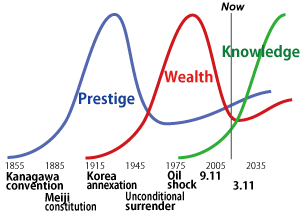 1. Sigmoid (S-Wave) curve: 1. Sigmoid (S-Wave) curve:
- Sigmoid of social change:
The
sigmoid curve, where usually 'time' is taken in horizontal axis,
while 'an appropriate magnitude' in vertical axis, can express similar
or repetitive phenomena or changes. That is, a chain of S-shaped
curve which expresses three phases of 'advent', breakthrough', and
'maturity'. In addition
to these, he added 'formation'
phase before the advent phase, and 'fixation
or decline' phase after the maturity phase: five
phases as a total.
- Particularly at the initial phase of formation, lots of challenges
and trials have done, but most of these will disappear without attaining
to full-scale advent phase.
- Furthermore, overshoot may cause bubble situation, and the degree
of termination of such bubble may fork for fixation or decline.
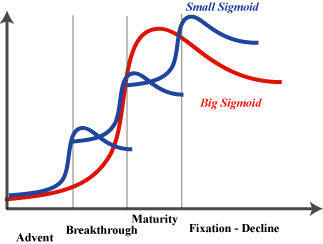 Fractal structure: Fractal structure:
And bigger sigmoid contains repetition of smaller sigmoids just
as a fractal structure.
- Sigmoidal and Long Wave: >Fig.
Also such a confusing situation that a certain maturity phase overlaps
with an advent phase of the next sigmoid could be a metaphor of
declining society; such chain of sigmoid can be observed as a fluctuation
of a long wave.
|
1. S字波の曲線:
- 社会変化のS字波:
S字波(Sigmoid) による局面分析では、横軸に時間、縦軸に適当な指標を取ると、似たような現象や変化が、「出現」・「突破」・「成熟」の3局面によるS字波の連鎖として現れる。これに、出現以前の「形成」局面と、成熟面のオーバーシュート後の「定着~衰退」局面を追加して5つの局面とした。
- 特に最初の形成局面では、多くの挑戦と試行が行われるものの、本格的な出現に至らず消滅するものも多い。
- オーバーシュートはバブルを生じさせ、その収束の程度によって定着する場合と衰退する場合とがある。
- フラクタル構造:
また大S字波は、フラクタル構造のように小S字波の反復として現れる。
- S字波と長波:
更に、成熟局面が次のS字波の出現局面と重なる混乱期は社会が下り坂に向かっているというメタファとなり得ることで、S字波の連鎖は長波の変動と見なすことができる。
-

|
>Top 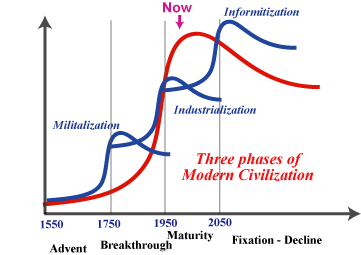 2. Depth
of Sigmoid: 2. Depth
of Sigmoid:
- The sigmoid can be dissolved into
the following five stages of smaller sigmoids according to the depth
of analysis.
- Sigmoid (depth-0) roughly classifies
the civilization into 'religious civilization', 'modern civilization',
and 'intelligence civilization as post-modern'.
- The sigmoid (depth-1) segments from
the year of 1550 when the modern civilization established into
bicentennial long phase of 'nationalization', 'industrialization',
and 'informatization'.
- The sigmoid (depth-2) segments into
three centennial phases of the depth-0 sigmoid; for example,
the industrialization phase is divided into from 'the 1st industrialization'
to 'the 3rd industrialization'.
- Similarly, sigmoid (depth-3) segments
into half-century long smaller phases of advent, breakthrough,
and maturation, and much smaller quater-century-long sigmoid
(depth-4), and (depth-5)
so on.
- Depth-1: Three phases of Modern
Civilization:
- Depth-2: Three phases of Industrialization:
|
2. S字波の深度:
- S字波は分析深度によって、以下の5段階のそれぞれの小S字波に分解できる。
- 深度0では、文明を宗教文明、近代文明、そしてポストモダンとしての智識文明に大別できる。
- 深度1では、近代文明が1550年から200年ごとに国家化、産業化、情報化の3局面に分かれる。
- 深度2では、国家化(=軍事化)、産業化(=企業化)、情報化の各局面が100年ごとの3局面に分かれる。たとえば産業化には、第一次から第三次産業革命が対応する。
- 同様に深度3は50年ごと
- 深度4 は25年ごと
- さらに深度5 と、各局面ごとに出現・突破・成熟の小局面に分解できる。
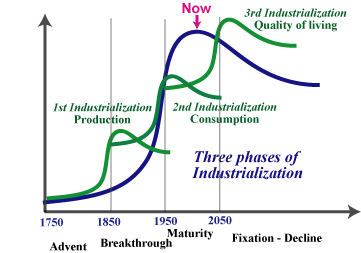
|
>Top 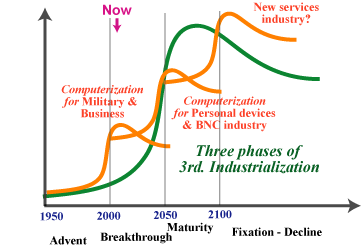 3. Third Industrial
Revolution: 3. Third Industrial
Revolution:
- The present situation (2004) :
The present is positioned to maturity phase of industrialization,
but in particular which belongs to breakthrough phase of
the third industrialization. The 3rd industrialization itself can
be divided into three smaller phases.
- Depth-3: Three phases of 3rd. Industrialization:
- The present also belongs to from the breakthrough phase
of the first stage featuring application of computer industry particularly
to military and business utilization, to the advent phase
of the second stage featuring robotics, personal mechanization,
and BNC (bio-nano-cognitive) industry .
- Depth-4: Thee small phases of the
advent phase of 3rd Industrialization: >Fig.
- The advent phase of the third industrialization could be observed
in three smaller phases, wherein the present has passed through
the first phase of fixation or decline of mainframe and
dumb terminal system, and belongs to from the second phase of breakthrough featuring server-client system and wired internet communication
to the third phase of the advent of ubiquitous devices,
optical technology, wireless internet and surveillance.
|
3. 第三次産業革命:
- 現在(2004)の位置:
現在は産業化の成熟局面であり、その中の第三次産業革命の突破局面に位置する。第三次産業革命も3局面に分かれる。
- 現在はまた、1番目のコンピュータ産業の軍事・ビジネス利用の突破局面から、2番目のロボット・個人用機械・Bio-Nano-Cognitive産業の出現局面に位置する。
- さらに細かい第三次産業革命の出現局面の3小局面で見ると、現在は1番目のメインフレームによる演算の時代は定着・衰退局面を迎え、2番目のサーバ・クライアント・有線インターネット・通信の突破局面から3番目のユビキタス・光・無線インターネット・監視の出現局面に位置する。
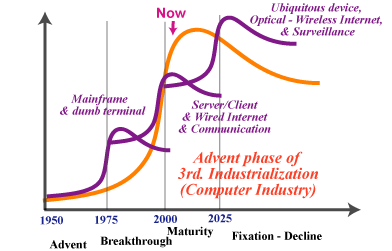 |
>Top 4. First Informatization
Revolution:
- At the same time, the present situation overlaps with the advent phase of informatization; in particular belongs from the advent and breakthrough phase of the first informatization.
- In more details of the three smaller phases of the first informatization,
the present can be described as belonging from the breakthrough phase of netizens and knowledge industry to the advent phase of development of the wisdom game.
- Depth-3: Three phases of 1st. Informatization:
- Furthermore the present can be described in the more detailed
scale of three phases: it has already passed through the first of fixation-decline phase of technocrat vs. hacker, and now
belongs to from the second maturity phase of NPO-NGO-Geek
to the third advent phase of smart mobs in the ubiquitous
environment. Such smart mobs are featured to participate in the
active discussion among homogeneous groups, however, they are reluctant
to take actions to organize majority, and they may be on their way
of becoming earlier netizens, but take no particular interest in democracy.
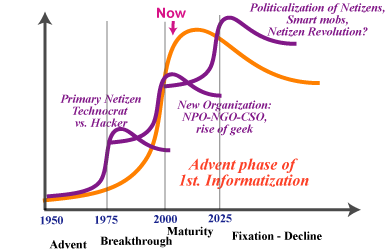
|
4. 第一次情報革命:
- 現在はまた、情報化の出現局面とも重なっており、その中では第一次情報革命の出現から突破局面に位置する。
- 第一次情報革命の3局面で見ると、現在は、1番目の智民・智業の台頭の突破局面から、2番目の智のゲームの展開の出現局面に位置する。
- さらに第一次情報革命出現局面を細かくした3小局面では、現在は1番目の初期智民であるテクノクラート対ハッカーの定着・衰退局面を経て、2番目のNPO-NGO-Geek(日本のオタク)の成熟局面から3番目のユビキタス環境のSmart
mobsの出現局面に位置する。このSmart mobsは同意見の仲間の中では議論はするものの、多数派としての行動をとることはなく、民主主義とも無縁なタイプとして初期智民の進化形として登場してくる。
|
>Top 5. Delayed &
Deformed Sigmoid:
- The industrialization in Japan shows from 60 to 90 years delayed
sigmoid compared with that of the Western Europe. The case of former
USSR shows deformed sigmoid without having breakthrough phase of industrialization for consumers.
- On the other hand, the case of Japan, after the successful industrialization
for consumers such as automobiles and home electronics, etc., cannot
attain the breakthrough phase in popularization of services
such as medical care, education, and entertainment, because Japan
still tends to sticker-in-mind in making goods as a manufacturer.
While the case of China or other Asian Countries are observed to
catch up the foregoing waves of the front runners in shorter years.
- It is reasonable to describe the sigmoid of Japan as delaying
60 years with that of Western Europe which spent almost 200 years
for the change of the sigmoid. In 1980s Japan passed through the advent phase of nationalization, and in 1940s the breakthrough phase of nationalization as well as the advent phase of
industrialization, and then in 2000s Japan enters into the breakthrough phase of industrialization as well as the advent phase
of informatization. It usually causes a kind of confusion when both
phases of breakthrough and advent phase concurrently
occur, but these overlapped phases can be regarded as a situation
of downtrend phase. It is not a curious coincidence that the enactment
or the revision of constitution of Meiji and Showa happened during
the bottom of these downtrend phase; even now revision of Heisei
constitution is in a matter of controversy.
|
5. 遅れてゆがんだS字波:
- 5. 産業化以降のS字波は、日本の場合は、西欧に比べ60年から90年遅れたS字波を示す。旧ソ連の場合は、1950年以降の消費者用の工業化を突破することなく崩壊を迎えた。
- また日本は消費者用の自動車・家電で突破した後、もの作りにこだわるあまり、医療・教育・娯楽などサービスの大衆化の局面の波に乗りきれていない。さらに遅れてきた中国やアジア諸国は、これら前の波を見つつ各局面をさらに短期間で追従しつつある。
- 日本の西欧化に着目すると、西欧が200年かかったS字波の変化をほぼ60年で追従してきたことがわかる。1880年代は、日本の国家化局面の出現期にあたり、1940年代は国家化局面の突破と産業化局面の出現となり、さらに2000年代に産業化の突破と情報化の出現とが重なっている。突破局面と出現局面が同時に起こるときには混乱が生じるが、これは下降局面的な状況と見なすことができる。この下降局面的な底に当たる時機に明治憲法、昭和憲法が制定・改憲され、今日また平成憲法論議が起きている。
|
>Top 6. Discussions go
on:
- After the above briefing by the lecturer, there were a volley
of questionnaire from the audience; propagating through the conference
room including such questionnaires:
- 1) the horizontal-axis should be inclination of growth instead
of simple time,
- 2) further analysis or explanation in the case of downtrend
phase,
- 3) relationship with catastrophe theory,
- 4) more cases out of the normal sigmoid curves, or analysis
of deformed sigmoid of Asian countries as the followers, etc.
|
6. 議論は続く:
- 以上が、公文GLOCOM所長による講演の概要である。会場からは、以下のような質問が出され、議論の波紋が限りなく広がっていくように思えた。
- 1) 横軸に時間ではなく成長勾配を取ることや、
- 2) 下降局面としての逆S字波のさらなる分析、
- 3) カタストロフィ理論との関係、
- 4) S字波に乗りきれなかった事例、アジアなど追従するS字波の歪みの分析など
|
 1. Sigmoid (S-Wave) curve:
1. Sigmoid (S-Wave) curve: Fractal structure:
Fractal structure:
 2. Depth
of Sigmoid:
2. Depth
of Sigmoid: 
 3. Third Industrial
Revolution:
3. Third Industrial
Revolution: 
